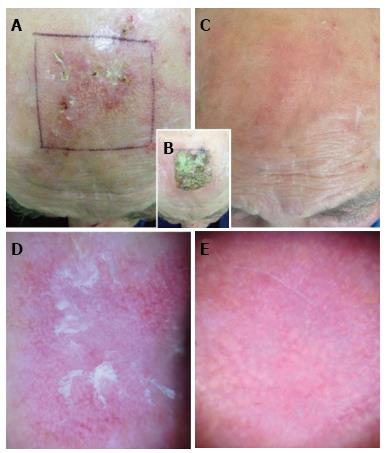Copyright
©The Author(s) 2017.
World J Clin Oncol. Oct 10, 2017; 8(5): 405-411
Published online Oct 10, 2017. doi: 10.5306/wjco.v8.i5.405
Published online Oct 10, 2017. doi: 10.5306/wjco.v8.i5.405
Figure 1 Patient treated with ingenol mebutate for actinic keratosis of the scalp.
A and C: Clinical images of the treated area before and after (day 57) the therapy, respectively; B: Local skin reaction to ingenol mebutate at day 8 showing a grade 3 crusting reaction and erythema exceeding the treated area (grade 4); D: Dermoscopic image of an actinic keratosis of the treated area at baseline showing red pseudonetwork and scaling in the central area; E: Dermoscopic picture of the same skin area at day 57 showing the complete disappearance of the preexisting actinic keratosis.
Figure 2 Number of skin reactions and scores at each follow up visit.
A: The number and features of different skin reactions over the time; B: Mean values describing the severity of each skin reaction and the LSR composite score (light blue line). Skin reactions included: Erythema (blue), flaking/scaling (red), crusting (green), swelling (purple), vesiculation/pustulation (light blue), and ulceration (orange). LSR: Local skin reaction.
- Citation: Skroza N, Proietti I, Bernardini N, Balduzzi V, Mambrin A, Marchesiello A, Tolino E, Zuber S, La Torre G, Potenza C. Factors influencing response to ingenol mebutate therapy for actinic keratosis of face and scalp. World J Clin Oncol 2017; 8(5): 405-411
- URL: https://www.wjgnet.com/2218-4333/full/v8/i5/405.htm
- DOI: https://dx.doi.org/10.5306/wjco.v8.i5.405










